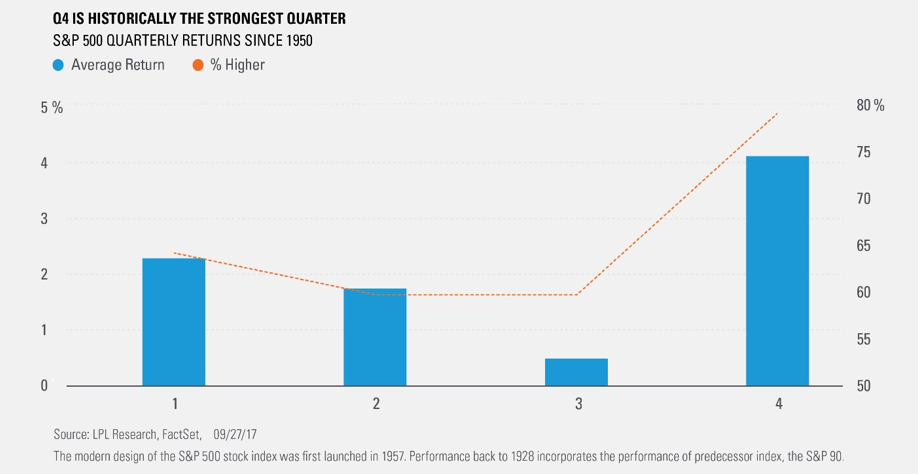2017 Third Quarter Report
2017 Third Quarter Report
The last few years of a bull market are always a bit of a mystery to professional investors; the market rises faster than it did in the early, cautious years when nobody believed there WAS a bull market, even though there appear to be fewer fundamental or economic reasons for it. The current bull market churns on, even if nobody can explain it, and people who bail out in anticipation of a downturn do so at the risk of missing out on an untold number of months or years of (still somewhat inexplicable) gains.
A breakdown shows that just about everything gained at least modestly in value these last three months. The Wilshire 5000 Total Market Index—the broadest measure of U.S. stocks—rose 4.59% for the most recent quarter, finishing the first three fourths of the year up 13.72%. The comparable Russell 3000 index is up 13.91% for the year so far.
Looking at large cap stocks, the Wilshire U.S. Large Cap index gained 4.50% in the third quarter, to stand at a 14.19% gain so far this year. The Russell 1000 large-cap index finished the first three quarters with a similar 14.17% gain, while the widely-quoted S&P 500 index of large company stocks gained 3.96% for the quarter and is up 12.53% in calendar 2017.
Meanwhile, the Russell Midcap Index has gained 11.74% so far this year.
As measured by the Wilshire U.S. Small-Cap index, investors in smaller companies posted a 5.39% gain over the third three months of the year, to stand at a 9.55% return for 2017 so far. The comparable Russell 2000 Small-Cap Index is up 10.94% this year, while the technology-heavy Nasdaq Composite Index rose 5.79% for the quarter and is up 20.67% in the first three quarters of the year.
As nice as the returns have been domestically, international stocks this year have been even kinder to investment portfolios. The broad-based EAFE index of companies in developed foreign economies gained 4.81% in the recent quarter, and is now up 17.21% in dollar terms for the first nine months of calendar 2017. In aggregate, European stocks have gone up 19.87% so far this year, while EAFE’s Far East Index has gained 12.31%. Emerging market stocks of less developed countries, as represented by the EAFE EM index, rose 7.02% in the third quarter, giving these very small components of most investment portfolios a remarkable 25.45% gain for the year so far.
Looking over the other investment categories, real estate, as measured by the Wilshire U.S. REIT index, posted a meager 0.61% gain during the year’s third quarter, and is now up 2.44% for the year so far. The S&P GSCI index, which measures commodities returns, gained 7.22% for the quarter but is still down 3.76% for the year. By far the biggest component is the ever-unpredictable price of oil. Since the bottom on February 11, 2016, crude oil prices have actually risen by 50%, but the trajectory has been choppy and unpredictable.
In the bond markets, you know the story: coupon rates on 10-year Treasury bonds have risen incrementally from 2.30% at this point three months ago to a roaring 2.33%, while 30-year government bond yields have also risen incrementally, from 2.83% to 2.86%.
One might imagine that the uncertainties around government policy and fundamental economic issues (failed attempts to repeal the Affordable Care Act and a new promise to write a new tax code, for example) would spook investors, and if those weren’t scary enough, there’s the nuclear sabre rattling sound coming from North Korea. Hurricanes have disrupted economic activity in Houston and large swaths of Florida, while Puerto Rico lies in ruins. Yet the bull market sails on unperturbed.
How can this be? Because if you look past the headlines, the underlying fundamentals of our economy are still remarkably solid this deep into our long, slow economic expansion. Corporations reported a better-than-expected second quarter earnings season, with adjusted pretax profits reaching an annualized $2.12 trillion—which means that American business is still on sound footing. Unemployment continues to trend slowly downward and wages even more slowly upward. The economy as a whole grew at a 3.1% annualized rate in the second quarter, which is at least a percentage point higher than the recent averages and marks the fastest quarterly growth in two years. There is hope that the new tax package will prove as business-friendly as the Trump Administration is promising.
Economists tell us that the multiple whack of hurricane damage will slow down economic growth figures for the third quarter, although the building boom fueled by the destruction will mitigate that somewhat. There are no economic indicators that would signal a recession on the near horizon, and one of the potential panic triggers—a Federal Reserve Board decision to recklessly raise interest rates—seems unlikely given the Fed’s extremely cautious approach so far.
Meanwhile, as you can see from the accompanying chart, fourth quarters have historically been kind to investors—much kinder than third quarters.
There are still potential speed-bumps down the road. The Trump Administration has threatened multiple trade wars with America’s major trading partners: the NAFTA members Canada and Mexico, and with China. Tight immigration rules could lead to limited labor supplies.
But it’s hard to be pessimistic when your portfolio seems to grow incrementally every quarter. The current 12-year stretch of economic growth below 3% a year is America’s longest on record. But if the U.S. charts a prudent economic course, it’s possible that the current expansion could at least set new records for longevity. This current expansion just turned 99 months old. The all-time record is 120 months, from 1991 to 2001. We may have to wait two more years for the next great buying opportunity in U.S. stocks.
 Sources:
Wilshire index data: http://www.wilshire.com/Indexes/calculator/
Russell index data: http://www.ftse.com/products/indices/russell-us
S&P index data: http://www.standardandpoors.com/indices/sp-500/en/us/?indexId=spusa-500-usduf–p-us-l–
Nasdaq index data:
http://quotes.morningstar.com/indexquote/quote.html?t=COMP
http://www.nasdaq.com/markets/indices/nasdaq-total-returns.aspx
International indices: https://www.msci.com/end-of-day-data-search
Commodities index data: http://us.spindices.com/index-family/commodities/sp-gsci
Treasury market rates: http://www.bloomberg.com/markets/rates-bonds/government-bonds/us/
Bond rates:
http://www.bloomberg.com/markets/rates-bonds/corporate-bonds/
General:
http://www.marketwatch.com/(S(jpgxu155hzygvlzbebtr5r45))/story/what-rose-in-the-third-quarter-stocks-bondsbasically-everything-2017-09-29?link=MW_story_latest_news
http://www.marketwatch.com/(S(jpgxu155hzygvlzbebtr5r45))/story/economys-2nd-quarter-growth-raised-to-31-2017-09-28?link=MW_story_latest_news
http://www.marketwatch.com/(S(jpgxu155hzygvlzbebtr5r45))/story/us-economy-likely-to-speed-up-in-2018-but-not-shatter-any-records-2017-09-25?link=MW_latest_news
Sources:
Wilshire index data: http://www.wilshire.com/Indexes/calculator/
Russell index data: http://www.ftse.com/products/indices/russell-us
S&P index data: http://www.standardandpoors.com/indices/sp-500/en/us/?indexId=spusa-500-usduf–p-us-l–
Nasdaq index data:
http://quotes.morningstar.com/indexquote/quote.html?t=COMP
http://www.nasdaq.com/markets/indices/nasdaq-total-returns.aspx
International indices: https://www.msci.com/end-of-day-data-search
Commodities index data: http://us.spindices.com/index-family/commodities/sp-gsci
Treasury market rates: http://www.bloomberg.com/markets/rates-bonds/government-bonds/us/
Bond rates:
http://www.bloomberg.com/markets/rates-bonds/corporate-bonds/
General:
http://www.marketwatch.com/(S(jpgxu155hzygvlzbebtr5r45))/story/what-rose-in-the-third-quarter-stocks-bondsbasically-everything-2017-09-29?link=MW_story_latest_news
http://www.marketwatch.com/(S(jpgxu155hzygvlzbebtr5r45))/story/economys-2nd-quarter-growth-raised-to-31-2017-09-28?link=MW_story_latest_news
http://www.marketwatch.com/(S(jpgxu155hzygvlzbebtr5r45))/story/us-economy-likely-to-speed-up-in-2018-but-not-shatter-any-records-2017-09-25?link=MW_latest_news
 Sources:
Wilshire index data: http://www.wilshire.com/Indexes/calculator/
Russell index data: http://www.ftse.com/products/indices/russell-us
S&P index data: http://www.standardandpoors.com/indices/sp-500/en/us/?indexId=spusa-500-usduf–p-us-l–
Nasdaq index data:
http://quotes.morningstar.com/indexquote/quote.html?t=COMP
http://www.nasdaq.com/markets/indices/nasdaq-total-returns.aspx
International indices: https://www.msci.com/end-of-day-data-search
Commodities index data: http://us.spindices.com/index-family/commodities/sp-gsci
Treasury market rates: http://www.bloomberg.com/markets/rates-bonds/government-bonds/us/
Bond rates:
http://www.bloomberg.com/markets/rates-bonds/corporate-bonds/
General:
http://www.marketwatch.com/(S(jpgxu155hzygvlzbebtr5r45))/story/what-rose-in-the-third-quarter-stocks-bondsbasically-everything-2017-09-29?link=MW_story_latest_news
http://www.marketwatch.com/(S(jpgxu155hzygvlzbebtr5r45))/story/economys-2nd-quarter-growth-raised-to-31-2017-09-28?link=MW_story_latest_news
http://www.marketwatch.com/(S(jpgxu155hzygvlzbebtr5r45))/story/us-economy-likely-to-speed-up-in-2018-but-not-shatter-any-records-2017-09-25?link=MW_latest_news
Sources:
Wilshire index data: http://www.wilshire.com/Indexes/calculator/
Russell index data: http://www.ftse.com/products/indices/russell-us
S&P index data: http://www.standardandpoors.com/indices/sp-500/en/us/?indexId=spusa-500-usduf–p-us-l–
Nasdaq index data:
http://quotes.morningstar.com/indexquote/quote.html?t=COMP
http://www.nasdaq.com/markets/indices/nasdaq-total-returns.aspx
International indices: https://www.msci.com/end-of-day-data-search
Commodities index data: http://us.spindices.com/index-family/commodities/sp-gsci
Treasury market rates: http://www.bloomberg.com/markets/rates-bonds/government-bonds/us/
Bond rates:
http://www.bloomberg.com/markets/rates-bonds/corporate-bonds/
General:
http://www.marketwatch.com/(S(jpgxu155hzygvlzbebtr5r45))/story/what-rose-in-the-third-quarter-stocks-bondsbasically-everything-2017-09-29?link=MW_story_latest_news
http://www.marketwatch.com/(S(jpgxu155hzygvlzbebtr5r45))/story/economys-2nd-quarter-growth-raised-to-31-2017-09-28?link=MW_story_latest_news
http://www.marketwatch.com/(S(jpgxu155hzygvlzbebtr5r45))/story/us-economy-likely-to-speed-up-in-2018-but-not-shatter-any-records-2017-09-25?link=MW_latest_news This article was written for information purposes only and its content should not be construed by any consumer and/or prospective client as rebel Financial’s solicitation to affect, or attempt to affect transactions in securities, or the rendering of personalized investment advice for compensation. No client or prospective client should assume that any such discussion serves as the receipt of, or a substitute for, personalized advice from rebel Financial, or from any other investment professional. See our disclosures page for more information.
Facebook
Twitter
LinkedIn
Email
Phil Ratcliff
Phil Ratcliff, President of rebel Financial, is a senior financial advisor that holds an AIF®, CFP®, ChFC®, and CLU® certifications. He started his career at American Express Financial Advisors in 2003, then moved to AXA Advisors for 7 years before founding rebel Financial LLC in 2013.







